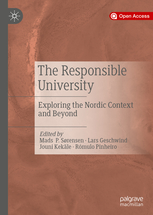
What is the ‘responsible university’? What does it mean for universities to address the Sustainable Development Goals? And what is specific about universities in the Nordic countries? These are some of the questions addressed in a new book ‘Responsible University: Exploring the Nordic Context and Beyond’, edited by Mads P. Sørensen (Aarhus University, Denmark), Lars Geschwind (KTH Royal Institute of Technology, Sweden), Jouni Kekäle (University of Eastern Finland, Finland) and Rómulo Pinheiro (University of Agder, Norway). This Open Access book can be freely downloaded here. In this Q&A with Europe of Knowledge blog, the editors explain rationales, key concepts and lessons from their book.
Q1: What have been the rationales and origins of this book?
The rationale for the book was the perceived need for a discussion about universities’ roles and contribution to our societies. The last decades, universities have become major players as far as knowledge creation and dissemination are concerned, sometimes described as being “engines of growth”. In our book, the focus is on the wider societal role of modern universities. In 2007, renowned political scientist Johan Olsen wrote an insightful essay focusing on the challenges facing European universities, in the light of their historical (institutionalized) features, and the various pressures – internally/externally, financially and otherwise – they currently face. Amongst other aspects, Olsen asks: “what type of university for what type of society?” More recently, Thomas Piketty’s work has drawn wide attention towards the growing socio-economic inequality facing Western nations. Several analyses have pointed to the importance of the educational system as the driving force behind changes in social mobility.
This raises an interesting set of questions with respect to the role of the modern university, not least given the (earlier) assumptions that massification of higher education systems worldwide would increase social mobility and, thus, contribute to a more egalitarian and fairer society. Yet, despite great strands in the expansion of access to higher education worldwide, the available figures suggest that, in a great number of countries, social mobility is on the decline. What is more, recent studies from the US reveal that income-related gaps both in access to higher education and in graduation rates are not only large but keep on growing. This brings to the fore the question of what the nature and function of the “good university” ought to be.
Q2: What is the ‘responsible university’?
Responsibility has become a catchword in all organisations, and it has become commonplace for business organisations to stress their responsible position and behaviour. The key areas of their attention tend to include responsibility for the environment, social responsibility, financial responsibility, as well as quality and sustainability issues. Given the broad use of the term responsibility, it is no wonder that higher education institutions also feel the need to show that they are operating in a responsible manner. We identify several reasons for this desire to portray sound operations, for example, a broad awakening to environmental issues, such as climate change, and other global challenges. Universities are key players in providing new knowledge; hence, it is easy to conclude that they can play a role in overcoming such challenges. In some cases, the opposite—being irresponsible—effectively creates an antidote.
Q3: How does the idea of a ‘responsible university’ fit into broader changes that the higher education sector is undergoing? Is it an alternative to New Public Management (NPM), neoliberalism and market approaches to higher education?
The responsibility agenda reflects a broader shift in society towards the increasing instrumentalization of the public sector at large, and the rise of a government-led accountability regime. As publicly funded institutions, universities are not immune to these pressures and are asked to clearly demonstrate how public investments in their core activities benefit society in the mid to long run. Shifts in governance regimes in the last 20 years, and sub-sequent reforms in the sector, have brought to the fore the issue of accountability on the one hand and performativity on the other.
The responsibility agenda both reflects (is shaped by) these broader developments and is a direct (strategic) response to this increasing external scrutiny in the inner life of public universities. Given the prevalence of performance management and other types of market dimensions, it is unsurprising that these elements are, to a large degree, part of the responsible university approaches observed in our study. As a result of the ambiguity associated with the various notions of, and perspectives on, responsibility in higher education, we would not expect these to replace current governance arrangements centered on market-based mechanisms. That said, it is not unthinkable – albeit less probable – that a socially-responsible agenda in higher education would raise new awareness towards the shortcomings and unintended consequences associated with instrumental approaches inspired by NPM and post-NPM governance regimes, as some of the chapters in our book allude to (e.g. irresponsible repertoires).
Q4: Is the term ‘responsible university’ related to the recently popular approach of Responsible Research and Innovation?
Responsible Research and Innovation (RRI) is an interesting example of the current discussion on responsibility. RRI has become a key term within the European Commission and has been part of the 7th framework programme as well as Horizon 2020. RRI builds on the two previous framework programmes’ idea of socio-technical integration. According to Owen, Macnaghten, and Stilgoe, RRI has three dimensions: First, it puts emphasis on “science for society”, i.e. it focuses on the ‘right impacts’ or that science delivers what society needs. Second, there is an emphasis on joining science with society: Science should evolve with the surrounding society. Third, the concept’s bridging of responsibility with innovation and research aims at stimulating actors within the field to reflect more critically on their roles and responsibilities as knowledge producers, co-creators and policy advisors.
Q5: Talking about the responsible university, your book mentions the United Nations’ Sustainable Development Goals(SDGs). At the moment, it seems very popular for universities to declare that they are contributing to the SDGs. Can you mention any good practices where universities have made a substantial contribution to the SDGs?
There is no doubt that global challenges and UN’s Sustainable Development Goals (SDGs) are at the forefront of a contemporary “responsible” approach. We also see many universities using the SDGs as a strategic vehicle for change, trying to balance academic freedom with a clear sustainability agenda. In Denmark, University of Southern Denmark is an example of such a development. It is all relatively new and it remains to be seen what will come out of these strategic shifts. SDGs are challenging problems and not just problems that the academia has to tackle.
Seeing, for example, climate change only as an academic problem is insufficient; such problems are also political and practical, embedded deeply in our civilization, and our industrial way of life. But on the other hand, there is no doubt that scientific solutions often provide the basis for wider social, political and cultural changes that are required to address such complex problems. This basis for change, in turn, requires action, coordination and collaboration across knowledge domains, sectors and types of organizations. As we discuss in the book, ‘knowledge co-creation’ becomes a central concept.
Q6: Your book is dedicated to the Nordic context (except one chapter that is about Indonesia). What is specific about the Nordic universities? Are they more responsible than universities in other regions? What can universities elsewhere learn from the Nordic universities?
In fact, the contributions by Benneworth and Karlsen & Larrea also build on experiences from outside the Nordics, namely; the UK, the Netherlands and Spain. Nordic higher education is deeply embedded in the so-called Nordic social-democratic model (based on trust, wide accessibility to public goods, safety net, professionalization, etc.), and the approaches towards responsibility in higher education reflect this orientation. Responsibility can only be enacted if a multiplicity of stakeholders are involved and trust one another. The Nordic corporate-pluralistic model, combined with a less hierarchical governance approach and a pragmatic attitude towards problem solving, presents actors in higher education, and beyond (other sectors), with a basic societal platform for developing and implementing responsibility agendas across the board. Furthermore, a culture of accountability is both highly praised and deeply institutionalized across Nordic societies, resulting in familiarities when it comes to instituting responsibility aspects within and across universities.
Stated differently, Nordic universities operate within an institutional framework – based on formal rules and informal relations – that facilitates the development of internal mechanisms for enhancing the societal impact of teaching, research and engagement by publicly funded universities. Hence, we would caution other countries to “copy and paste” successful elements or scripts from the Nordics since these are dependent on the institutional (societal and field level) conditions under which universities operate – which may differ from country to country. That said, some key lessons can be learnt, not least when it comes to nurturing an institutional environment that focuses on openness, trust and stakeholder engagement. Ironically, some of these aspects have been negatively affected by recent reforms stressing efficiency and control, resulting in a decline in trust amongst key actors.
Q7: What are the main lessons from your book for practitioners and policy-makers?
For several decades – and increasingly – universities are expected to demonstrate short-term social relevance, and to react to external demands for accountability. Consequently, all universities should take responsibility seriously, but in practice this implies flexibility. Each individual academic or sub-unit need to be given considerable leeway in interpreting how this can be done in reality. Since there is no best practice that fits all, responsibility becomes a relational issue, it becomes a question of balancing stakeholders’ expectations with the institution’s profile, competences and priorities.
Academic freedom is a fundamental criterion that needs to be respected. Academic norms and traditions are not always aligned with external needs and expectations. The book’s message to practitioners and policy-makersis therefore also, that the demand-response imbalance, as Burton Clark called it, has only gotten deeper, since he coined the term in 1998. This has led to a situation of an overflow of expectations and demands on universities. However, as demonstrated in the book, joint efforts between a university and external stakeholders can be very fruitful if the mutual interests are clarified in advance and are close enough to allow a productive cooperation.
Q8: What would be interesting avenues for future research?
Future research could, for example, investigate how different stakeholders within and outside the university make sense of the responsible agenda. We also need more research on university-society relationships, not least, on how external demands and expectations are dealt with within the university system. In relation to the responsibility agenda, it would for example be interesting to examine the long-term effects within universities of this agenda.
This entry was initially published on Europe of Knowledgeblog.

